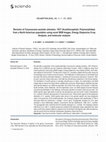Papers by Hridaya Shanker Singh
Systematic parasitology, Feb 26, 2024
Journal of Applied and Natural Science, Jun 1, 2011
The present communication deals with a larval nematode belonging to the genus Thubunaea Seurat, 1... more The present communication deals with a larval nematode belonging to the genus Thubunaea Seurat, 1914, from the body cavity of an insect, Supella sp., at Meerut, U.P. Both encysted and free larval stages were recovered. Morphology of the larvae is described in detail.

International Journal of Infectious Diseases, Apr 1, 2016
Background: Despite of remarkable progress in combating malaria, this deadly disease still accoun... more Background: Despite of remarkable progress in combating malaria, this deadly disease still accounts for more than a half million deaths annually. In the light of growing incidences of drug resistance, an understanding of parasite biology is necessary for the development of new antimalarials. During life cycle in two different hosts Plasmodium falciparum experiences frequent thermal variations and physiological stress. Heat shock proteins (Hsps) are key players for its survival and making them attractive drug targets. Hence, present research emphasizes on in silico analysis, cloning and production of a type III Hsp40 protein, PfZRF1. Methods & Materials: Orthologs of PfZRF1 were assigned by BLASTp and literature search. Domain architecture was drawn by SMART and Pfam. ClustalW and T-coffee were employed for multiple sequence alignment analysis. Phylogenetic tree was generated by NJ method using Phylip-3.695 for evolutionary relationship analysis. PfZRF1 and its domain constructs were amplified and cloned in pETM11 vector between NcoI, XhoI and Kpn1 restriction sites. His-tagged PfZRF1 and other domain constructs were expressed in E. coli B834. Results: PfZRF1 orthologs were identified in 31 eukaryotes however found to be absent in prokaryotes. PfZRF1 is composed of a Hsp70-binding DnaJ domain and two DNA-binding SANT domains. An ubiquitinated histone H2A binding UBD domain was also identified based on human ortholog HsZRF1. As compared to HsZRF1, DnaJ domain has a 50 aas long parasite-specific insertion in loop region between helix II and III near Hsp70-binding HPD motif. Additionally, ribosome associating RAC head domain was found less conserved with many insertions in PfZRF1. Phylogenetic analysis depicted PfZRF1 to be closer to unicellular eukaryotes. Full ORF (2820 bp) and several constructs covering different domains were amplified and cloned in pETM11. Different constructs were expressed after inducing with 0.5 mM IPTG at 16 • C in E. coli B834 cells for soluble expression. This study presents preliminary characterization of a type III Hsp40 co-chaperone of the parasite. Further functional characterization of this putative multifunctional chaperone would undoubtedly provide an insight in parasite molecular biology for the development of novel antimalarials.
Journal of nematode morphology and systematics, 2013
Oxyurid nematodes parasitizing the mole cricket Neoscapteriscus vicinus were isolated in the fram... more Oxyurid nematodes parasitizing the mole cricket Neoscapteriscus vicinus were isolated in the framework of sampling fields of mole-crickets from the pampean region, in Argentina. In this work, molecular characterization of the 18S rRNA partial sequence of nematodes belonging to the families Thelastomatidae (Cameronia arecoensis Marchissio and Miralles 1987) and Travassosinematidae (Binema korsakowi Sergiev 1923 and Binema klossae, Marchissio and Miralles 1993) were carried out. This is the first world report of sequences belonging to B. klossae and C. arecoensis and first Argentinian report of B. korsakowi sequence. Also, morphological and morphometric features of B. klossae, B. korsakowi and C. arecoensis from Argentinian populations are reported.

Acta Parasitologica, Apr 27, 2022
PURPOSE Immature Southwellina hispida (Van Cleave, 1925) Witenberg, 1932 from the body cavity of ... more PURPOSE Immature Southwellina hispida (Van Cleave, 1925) Witenberg, 1932 from the body cavity of the paratenic host Gillichthys mirabilis Cooper (Gobiidae) in California are described. METHODS New Scanning Electron images and features of micropores, hook and spine Gallium cut sections and chemistry using Energy Dispersive X-ray analysis (EDXA), and molecular profile are provided for the first time. The 18S rDNA and mt Cox1 sequences were performed for molecular and phylogenetic study. RESULTS Our specimens were somewhat comparable to those reported from other paratenic hosts in Asia, Europe, and North and South America but varied in relative sizes of trunk and other structures, proboscis formula, and distribution of trunk spines. About 60 publications were reviewed of which one third included line drawings used for comparative morphometrics. In our specimens, the trunk measured 2.72-3.10 mm long by 0.92-1.07 mm wide and the proboscis 700-800 × 270-312 μm had 20-21 rows of 14-15 hooks each measuring 47-55 long by 12-15 μm wide at base anteriorly, 47-48 × 20-23 μm at middle bulge, and 43-50 × 13-20 μm basally. These measurements, among others were compared with measurements of juveniles from 13 other collections world-wide and intraspecific variability was noted especially in the shape of hook roots that were occasionally misinterpreted. EDXA showed hooks with high levels of Sulfur especially at the tip and edge of all hooks and low levels of Calcium and Phosphorus. Anterior spines had higher levels of Sodium but Gallium cut spine sections had higher levels of Calcium at middle and of Sulfur at base of spines. Micropores were variably distributed on the body wall and extended to the cortical layer of spines. Gene sequences of the 18S and the mitochondrial cytochrome c oxidase subunit 1 (cox 1) region were amplified for specimens of S. hispida. Molecular phylogenetic analysis inference from 18S rDNA and mt Cox1 gene sequences show a close relationship with previously reported myxozoan sequences available on GenBank database. Phylogenetic analysis positioned our S. hispida in a well-supported clade including other members of Polymorphidae. CONCLUSION The present study combined morphological, morphometric and molecular data to identify S. hispida.

Helminthologia, Feb 9, 2017
The nematode, Procamallanus spiculogubernaculus Agarwal, 1958 was found from the Stinging catfi s... more The nematode, Procamallanus spiculogubernaculus Agarwal, 1958 was found from the Stinging catfi sh, Heteropneustes fossilis (Bloch, 1794) from Ghazipur, Delhi, India. Morphological characterization, including scanning electron microscope observation supplemented with DNA sequences is provided. Specimens recently found are characterized by the presence of an unlined buccal capsule having a small basal ring, esophagus muscular and glandular, vulva position is slightly post-equatorial, tail conical, long, and ending in three digit-like processes, phasmids present at about mid-length and cloaca located at the posterior end. In this study the species P. spiculogubernaculus is validated on the basis of molecular data after 47 years from its original description. In the scanning electron microscope examination, the topology of mouth and sensory pits in anterior portion, while the phasmids and digit like processes in posterior portion is clearly observed. Molecular data of the 18S ribosomal RNA and mitochondrial cytochrome c oxidase subunit 1 (cox1) gene were analyzed. Molecular phylogenetic analyses supported the validity of Procamallanus spiculogubernaculus and confi rmed the paraphyletic status of the members of Procamallanus, Spirocamallanus, Camallanus and Paracamallanus. Taxonomic status of members of the family Camallanidae are briefl y discussed along with the results of the systematic evaluation of P. spiculogubernaculus based on molecular data.

Vestnik Zoologii, Oct 1, 2014
specimens were collected from host Catla catla from the river Brahmaputra, Guwahati, Assam, India... more specimens were collected from host Catla catla from the river Brahmaputra, Guwahati, Assam, India. The Dactylogyrus samples were examined by morphological and molecular methods. This parasite was originally described from Labeo rohita from fish farm Kalyani, West Bengal, India, but the morphological study of sclerotized parts showed the existence of D. labei on Catla catla. This is the first record of D. labei from Catla catla in India. K e y w o r d s: Monogenea, Phylogeny, 28S, ribosomal DNA, Assam, India. Морфологическое переописание и молекулярные параметры Dactylogyrus labei (Monogenea, Dactylogyridae) от Catla catla: находка нового хозяина в Индии. Чиари Х. З., Чаудхари А., Сингх Х. С. -Экземпляры атипичной формы Dactylogyrus labei Musselius et Gusev, 1976 были собраны с индийского карпа Catla catla из реки Брахмапутра (Гувахати, Ассам, Индия) и исследованы с помощью морфологических и молекулярных методов. Этот паразит был впервые описан на Labeo rohita с рыбной фермы Кальяни, Западная Бенгалия, Индия, но морфологическое исследование склеротизированных частей показало, что D. labei паразитирует и на Catla catla. Это первая находка D. labei на Catla catla в Индии. К л ю ч е в ы е с л о в а: Monogenea, филогения, 28S, рибосомальная ДНК, Ассам, Индия.

Journal of Helminthology, 2021
Pallisentis(Pallisentis)nandaiSarkar, 1953 is a freshwater fish parasite restricted to the Indian... more Pallisentis(Pallisentis)nandaiSarkar, 1953 is a freshwater fish parasite restricted to the Indian subcontinent in the Ganga River and its tributaries. It was described from the leaffish,Nandus nandus(Hamilton) from the Ganga River delta at Calcutta. We recovered variant specimens from the same host species from the Ganga near its headwaters at Bijnor about 1500 km away. Our specimens were clearly identifiable asP. nandaibut varied considerably from those in the original description, especially in the size of proboscis hooks, receptacle and lemnisci. The original description was incomplete (missing line drawings of female trunk and reproductive system, male trunk, complete proboscis, hooks and hook roots) and inaccurate (proboscis, hooks, receptacle wall), and some measurements were lumped together for both sexes. We provide a complete description and include new morphological information including the first description of para-receptacle structure in the genusPallisentisVan Cleave, 1928, scanning electron microscopy and microscope images, molecular analysis, and energy dispersive X-ray analysis (EDXA) of hooks and spines of our specimens for the first time. Additional details of proboscis hook roots, trunk spines, micropores and micropore distribution are described. The unique metal composition of hooks (EDXA) demonstrated a considerably high but variable level of sulphur and negligible level of calcium in collar and trunk spines and hook tips, but a higher level of sulphur and calcium at the hook basal arch than at the hook tip and edge. A comparison with the EDXA pattern of another species ofPallisentis,P. İndicaMital &amp; Lal, 1976, were considerably different. The phylogenetic position ofP. nandaiwithin Eoacanthocephala was generated to assess the molecular characterization based on 18S and ITS1-5.8S-ITS2 ribosomal DNA sequences. Maximum likelihood and Bayesian inference analyses placedP. nandaiin a clade with otherPallisentisspecies under the family Quadrigyridae. This is the first report based on molecular evidence forP. nandai.

Journal of Parasitology, Oct 1, 2017
The diversity and taxonomy of diplostomids infecting freshwater fishes of the Indian region are p... more The diversity and taxonomy of diplostomids infecting freshwater fishes of the Indian region are predominantly poorly known. Yet compared to other trematodes, identification and discrimination of diplostomid metacercaria are difficult using morphology and site of infection. The present study provides the first molecular study of Tylodelphys sp. from India. Specimens of Tylodelphys were collected from the vitreous humor of the eyes and from the brains of siluriform fish, Mystus tengara (Siluriformes: Bagridae) from Hastinapur, Meerut (U.P.), India. Taxonomic studies were performed on the basis of morphological, morphometrical, and molecular analysis. The dissimilarities in morphological and sites of infection between 2 forms of Tylodelphys, designated as Tylodelphys sp. 1 and Tylodelphys sp. 2 suggested that the forms were different species but after performing molecular analysis, we conclude that despite morphological differences, both morphotypes are conspecific.

Helminthologia, Mar 1, 2023
We describe a population of the acanthocephalan Corynosoma australe Johnston, 1937 (Polymorphidae... more We describe a population of the acanthocephalan Corynosoma australe Johnston, 1937 (Polymorphidae) from a California sea lion Zalophus californianus (Lesson, 1828) in California using novel scanning electron microscopy (SEM) images, Energy Dispersive x-ray analysis (EDXA), and molecular analysis for the fi rst time. The taxonomic history of C. australe is replete with accounts using only line drawings some of which proved erroneous. The distribution of ventral spines on the female trunk has been the primary distinction between C. australe and Corynosoma obtuscens Lincicome, 1943, its junior synonym; being continuous in the latter but discontinuous posteriorly in the former species. The distribution of ventral spines is invariably discontinuous in males. Our redescription and SEM images help to resolve this issue further validating the synonymy. Morphological variability has been documented between our California population and others from various host species in California, South Australia, South Shetlands, and the Argentinian coast. Our SEM images document features not previously detectable in line drawings, erroneously reported or missed in previous accounts. The EDXA spectra show high levels of calcium and phosphorous and low levels of sulfur characteristic of C. australe. EDXA for other species of Corynosoma Lühe, 1904 provide support for the diagnostic distinction of C. australe. EDXA spectra were shown to be species specifi c and have diagnostic value in the taxonomy of the Acanthocephala. Our molecular analysis used amplifi cation of 18S of ribosomal DNA and cytochrome c oxidase 1 (Cox1) gene. Phylogenetic analyses for Cox1 gene revealed a close relationship between Corynosoma hannae Zdzitowiecki, 1984 and C. australe. The phylogenetic trees confi rmed that the isolates belonged to C. australe. The haplotype network inferred by Cox1 with C. australe sequences revealed that haplotypes clearly separated from each other and formed clusters related to samples from the Northern Hemisphere (the USA and Mexico), and the second from the Southern Hemisphere (Argentina, Brazil and Peru).
Helminthologia, Nov 21, 2016
Three species of digenetic trematodes are redescribed based on specimens collected from the intes... more Three species of digenetic trematodes are redescribed based on specimens collected from the intestine of freshwater fi shes of Hastinapur and Meerut (U.P.
Parasitology International, Apr 1, 2023

Folia Parasitologica, Jan 5, 2022
Specimens of Neoechinorhynchus (Neoechinorhynchus) poonchensis sp. n. are described from Schizoth... more Specimens of Neoechinorhynchus (Neoechinorhynchus) poonchensis sp. n. are described from Schizothorax richardsonii (Gray) in the Poonch River, Jammu and Kashmir. Specimens are thick-walled with dissimilar dorsal and ventral para-receptacle structures, anteriorly manubriated hooks, two giant nuclei in each lemniscus and many subcutaneousy. The lemnisci barely overlap the larger anterior testis, the cement gland has eight giant nuclei, and the seminal vesicle is large with thin walls. The vagina is unremarkable but the long uterus is made up of four specialised regions. Neoechinorhynchus rigidus , resembles N. poonchensis sp. n. It is distinguished from N. poonchensis sp. n. by having smaller trunk, proboscis, and male reproductive structures, equal testes, unequal lemnisci with three giant nuclei each, and much larger anterior proboscis hook (130 μm in males) than that originally described by Van Cleave (1928) (70 μm in a female). Anterior hook length alone is sufficient to conclude that the N. rigidus of Datta (1937) is not the same species as the N. rigidus of . species remains valid and that of is considered a different species named Neoechinorhynchus pseudorigidus sp. n., herein. Micropores of N. poonchensis sp. n. have variable distribution in different trunk regions and the Energy Dispersive X-ray analysis demonstrated higher levels of sulfur and lower levels of calcium and phosphorus. Sequences of the 18S rDNA gene from nuclear DNA, and cytochrome c oxidase subunit I (cox1) from mitochondrial DNA of N. poonchensis sp. n. were amplified and aligned with other sequences available on GenBank. Maximum likelihood (ML) and Bayesian inference (BI) analyses inferred for 18S rDNA and cox1 showed that N. poonchensis sp. n. was nested in a separate clade.
Journal of nematode morphology and systematics, 2011

Acta Parasitologica, Jan 14, 2019
Introduction Myxozoan infections of Indian freshwater fishes are relatively well studied, but the... more Introduction Myxozoan infections of Indian freshwater fishes are relatively well studied, but their validity is supported with molecular and phylogenetic data only for a few species. Objectives The primary objective was to present molecular data for two Myxozoan species, Myxobolus cylindricus and Henneguya gachua collected from Indian freshwater fishes, the dwarf snakehead Channa gachua and the striped dwarf catfish Mystus vittatus, respectively. Methods Various organs of 56 C. gachua and 48 M. vittatus were dissected. Myxozoan plasmodia with mature spores were collected from the gills under a dissecting microscope. Spores obtained from plasmodia from infected hosts were fixed in 80% ethanol in vials and sent for further morphological and molecular examinations to Hungary. The 18S rDNA gene of Myxobolus and Henneguya spp. was amplified using nested polymerase chain reaction (PCR). Phylogenetic analysis was performed using maximum likelihood (ML) and Bayesian inference (BI) methods. Results Morphological characteristics of M. cylindricus and H. mystasi spores corresponded to the original descriptions made by Sarkar, Mukhopadhyay, 1997, respectively. Phylogenetic analysis of the 18S rDNA gene revealed that the sequences of M. cylindricus differed from those of most Indian Myxobolus sp., known mostly from cyprinid fishes and formed a subgroup with Myxobolus neurophilus, a parasite of a perciform host, and with Henneguya chaudhuryi, a species belonging to a different genus but described from a closely related channid host. It was also closely related to another Henneguya species, H. lesteri, described from Sillago analis, a coastal fish. Henneguya mystasi had the closest similarity to Henneguya bicaudi, a species described from an Indian cyprinid fish and to Henneguya pellucida reported from a characid fish known from South America. Conclusion Molecular data received by us gives a solid basis for further identification of these myxozoans, the pathogenicity of which probably plays an economic role at culturing the hosts.
The Scientific Temper
Parasitological studies on helminths of freshwater fish in district Poonch, Jammu and Kashmir, In... more Parasitological studies on helminths of freshwater fish in district Poonch, Jammu and Kashmir, India is scarce that should be well-understood in order to assess their biodiversity. As compare to other regions in Jammu and Kashmir, India, less comprehensive studies is available with unpublished records. Here, we present a list of parasites that we have collected comprises a list of helminth parasites, their host species, and locality. This study contributes to the diversity of helminth parasites from River Poonch, Jammu and Kashmir, India that helps to identify the lacunae in our knowledge of this region.
longicirrus (Monogenea: Dactylogyridae) based on the 18S and ITS 1 ribosomal genes
Journal of Parasitology, Feb 28, 2019
India Molecular Profile Phylogenetic Relationships Pallisentis (Brevitritospinus) indica Mittal a... more India Molecular Profile Phylogenetic Relationships Pallisentis (Brevitritospinus) indica Mittal and Lal, 1976 was found infecting the spotted snakehead Channa punctatus Bloch and Schneider (Channidae) from Meerut, Uttar Pradesh (U.P.), India. The species was identified on the basis of proboscis hooks, trunk spines, and other structures that separate it from all described species. Molecular analysis based on 18S rDNA placed the P. indica isolates within a clade of Pallisentis spp. but distinct from other representatives of the same genus. This study documents the first molecular characterization of P. indica from India.

Infectious Diseases
The most prominent parasitic disease of the human central nervous system is neurocysticercosis, a... more The most prominent parasitic disease of the human central nervous system is neurocysticercosis, a neurologic parasite disease brought on by the engorged larva of the tapeworm Taenia solium. It is the most frequent cause of acquired epilepsy in endemic areas and a problem for the bulk of the developing world’s public health systems. However, because of globalisation, neurocysticercosis cases are now also increasing in wealthy nations. With two intermediate hosts (i.e., pigs and humans) and one final host, neurocysticercosis has a complicated disease path, through faecal-oral contamination, one contracts it. Neurocysticercosis is the most significant CNS parasite that causes severe illness. Based on the location of the disease, it has historically been classified into active and inactive types. Radiologists must be aware of the differential diagnosis because of the wide variety of its imaging appearances. Imaging results are influenced by the number and distribution of parasites as we...

Journal of Helminthology
Fully developed, sexually mature small male and female acanthocephalans, Microsentis wardae Marti... more Fully developed, sexually mature small male and female acanthocephalans, Microsentis wardae Martin & Multani, 1966 (Neoechinorhynchidae) reaching only 2.25 mm and 2.42 mm, respectively, were collected from the rectum of longjaw mudsuckers, Gillichthys mirabilis Cooper, in the salty marches of Anaheim Bay and San Diego Bay, California. Our specimens were half the size of those reported in the original description from the same host in Scammon's Lagoon over 700 km to the south. The ratio of proboscis and receptacle size to trunk size was markedly higher in our specimens compared to the larger specimens measured in the original description. The anatomy of all structures in our specimens from Anaheim Bay was comparable to that of the larger Scammon's Lagoon specimens that have apparently realized more growth in the Scammon's Lagoon. We have observed more structures that are not reported in the original description, especially evident from our scanning electron microscopy ima...











Uploads
Papers by Hridaya Shanker Singh